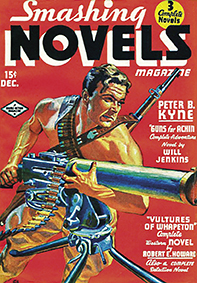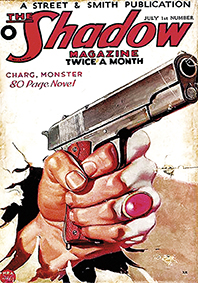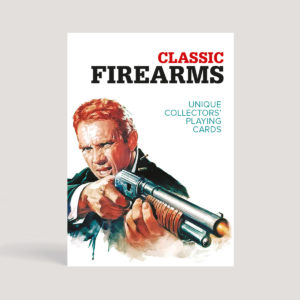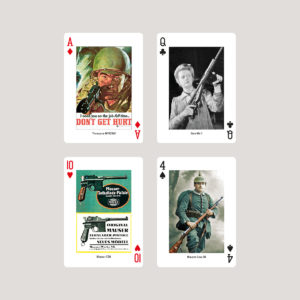GUNS SINCE WATERLOO
‘Whatever happens, we have got / The Maxim gun, and they have not’ wrote Hilaire Belloc. At the Battle of Omdurman (1898), where Churchill charged with the 21st Lancers, 50,000 Dervishes were faced by Kitchener’s 25,000 trained troops. Kitchener – ‘a great poster if not a great man’ (Margot Asquith) – had 44 Maxim machine guns. The Dervishes, armed with spears and a few old rifles, were massacred. Kitchener (who, to Churchill’s horror, shot wounded tribesmen) lost 48 dead. The Dervishes lost 11,000!
RAPID FIRE
 Suppressing fire, the ability to outgun your enemy, is key to prevailing in a firefight. In WW2, the German Mauser MG 42 could fire 1500 rounds per minute. Twice anything the Allies had. Most WW2 firefights occurred at close range, so the Germans also pioneered a select-fire assault rifle with the firepower of a submachine gun – the StG 44. It led to the Soviet AK-47, beloved by insurgents for its indestructability. In Vietnam US forces found it outgunned them. The M16 (1964) was the answer: high-powered but light. Gangsters and terrorists are not squeamish about collateral damage and thus favour rapid-firing machine pistols like the Czech Škorpion vz. 61 (1959) – used in the Paris Charlie Hebdo attack. After Waterloo, rate of fire was seen as pivotal. Richard Gatling, an American dentist, patented his Gatling gun in 1862. Ironically, he thought it would end war by its sheer brutality: 200 rpm, with the barrel rotating. Hiram Maxim designed the first modern machine gun (1883). It used recoil energy to fire 500 rpm. This, and its German derivative the MG 08 (and the Browning and Hotchkiss) dominated no man’s land in WW1. War was transformed.
Suppressing fire, the ability to outgun your enemy, is key to prevailing in a firefight. In WW2, the German Mauser MG 42 could fire 1500 rounds per minute. Twice anything the Allies had. Most WW2 firefights occurred at close range, so the Germans also pioneered a select-fire assault rifle with the firepower of a submachine gun – the StG 44. It led to the Soviet AK-47, beloved by insurgents for its indestructability. In Vietnam US forces found it outgunned them. The M16 (1964) was the answer: high-powered but light. Gangsters and terrorists are not squeamish about collateral damage and thus favour rapid-firing machine pistols like the Czech Škorpion vz. 61 (1959) – used in the Paris Charlie Hebdo attack. After Waterloo, rate of fire was seen as pivotal. Richard Gatling, an American dentist, patented his Gatling gun in 1862. Ironically, he thought it would end war by its sheer brutality: 200 rpm, with the barrel rotating. Hiram Maxim designed the first modern machine gun (1883). It used recoil energy to fire 500 rpm. This, and its German derivative the MG 08 (and the Browning and Hotchkiss) dominated no man’s land in WW1. War was transformed.
MUSKETS AND RIFLES
At Waterloo the British had the new Baker rifle. The rifled barrel (a German invention) spun the cartridge. It thus went further and more accurately (up to 500 metres). The Brown Bess, Britain’s flintlock musket from 1722-1838 (used mainly for volley fire) had a range of 100 metres but could fire 4 rounds a minute, the Baker only two. Both used bayonets for close quarters (rare, a frantic charge often scattered your foe). The bayonet killed; but mostly opened tins and barbequed. The 19C saw advances in speed of fire and reliability. Breach-loading rifles like the British Lee-Metford (1888) could fire 10 rpm. It saved the day at Rorke’s Drift (1879 – see the film Zulu). The American sewing machine expert, Oliver Winchester, saw Smith & Wesson’s design for a repeating rifle and liked it so much he bought the company. The 15-round Winchester 73 (Billy the Kid’s favourite) and the Colt Peacemaker revolver (also 1873), which used the same .44 rimfire ammo, were the guns that ‘won the West’. The dissolute Doc Holliday preferred to kill with a shotgun, a defensive weapon requiring no steady hand.
BOLT-ACTION AND REPEATING RIFLES
 The US Civil War spawned the 7-shot Spencer and the 16-shot Henry repeating rifles, but they were in short supply. Out of the Franco-Prussian War (1870-71) came Germany’s Mauser Gew 98, their robust bolt-action WW1 weapon. The lessons of the Boer War led to the .303 SMLE (with a 10-round magazine), the British mainstay during two world wars, capable of 20 rpm. 17 million were made. The French Lebel Model 1886, using a new metal smokeless cartridge, improved upon the deficiencies of the (paper cartridge) Chassepot (1866-74). Oswald used a variant of the robust Italian WW1 Carcano M91 (an M91/38) to kill JFK. Equally timeless was the Austro-Hungarian Mannlicher M95, used in two world wars and after.
The US Civil War spawned the 7-shot Spencer and the 16-shot Henry repeating rifles, but they were in short supply. Out of the Franco-Prussian War (1870-71) came Germany’s Mauser Gew 98, their robust bolt-action WW1 weapon. The lessons of the Boer War led to the .303 SMLE (with a 10-round magazine), the British mainstay during two world wars, capable of 20 rpm. 17 million were made. The French Lebel Model 1886, using a new metal smokeless cartridge, improved upon the deficiencies of the (paper cartridge) Chassepot (1866-74). Oswald used a variant of the robust Italian WW1 Carcano M91 (an M91/38) to kill JFK. Equally timeless was the Austro-Hungarian Mannlicher M95, used in two world wars and after.
PISTOLS
At Waterloo, pistols were redundant after firing as reloading was tricky when confronted by a bloke you’ve just tried to kill. The revolver, patented in 1835 by an American, Samuel Colt, changed the handgun game, with its 6 shots. It held sway until automatic pistols, like the iconic German Luger (1900). The Colt M1911 (with the magazine in the grip) became the US service pistol and is still used today. Movies often feature cops with unwieldy guns like a .44 Magnum. More realistic was the discreet Walther PPK carried by James Bond, deadlier than his anaemic Beretta 418. In the Depression era, the famous six-shot S&W Model 10 (from 1899), aka .38 Special, was the favourite sidearm for cops and robbers, but it took the S&W .38/44 to shoot through a hoodlum’s body armour and limo. Capone was arrested in Philly for carrying a concealed snub nosed .38 Special (not to be confused with a Saturday Night Special – any junk gun used by stick-up men and wife beaters). Drug gangs now use powerful ‘nines’ (9mm autos).
SUB-MACHINE GUNS
Compared to the famous Thompson submachine gun (from 1921), also popular with gangsters, the British Sten was a bit of cheap tin. ‘You’re just a bloated piece of pipe / You couldn’t hit a hunk of tripe’ wrote one poet. Yet it was a useful wartime expedient – especially for the Maquis.
But do the best of these weapons constitute… progress? Well, as the American sage and wit, Will Rogers, said – ‘You can’t say civilization don’t advance… in every war they kill you in a new way.’


